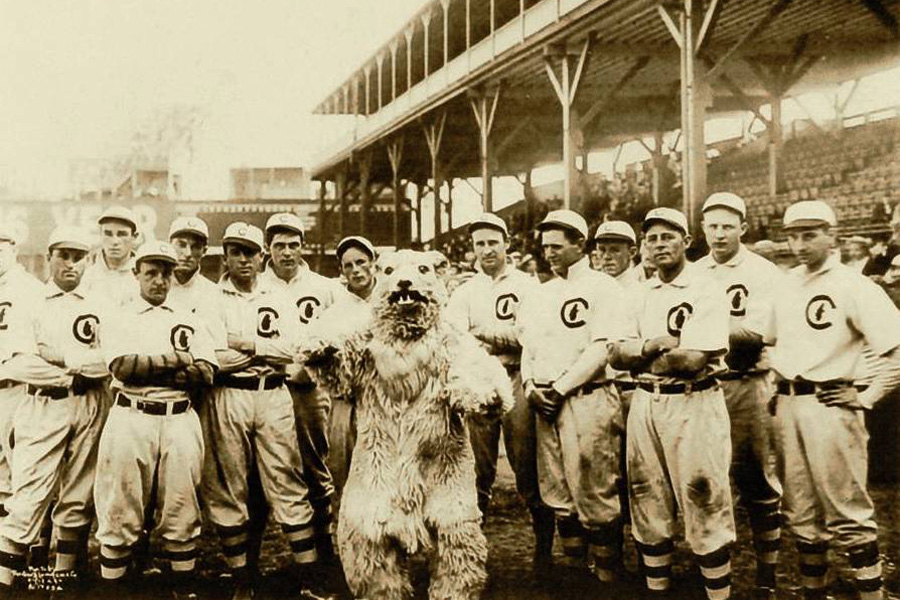The Chicago Cubs won their last World Series, against the Tigers, in Detroit 107 years ago. The final game, played on October 14, 1908, took place a whole 13 years before the first baseball radio broadcast. Nonetheless, Cubs fans—thousands of them—bought relatively cheap tickets to follow the game live in venues as august as the Chicago Auditorium Theatre. How? By watching a scoreboard that was manually updated with news relayed over teletype.
It probably looked something like this, which the Washington Post put up for the 1912 World Series:

Or like the Playograph (h/t Roy Edroso), which the New York Herald placed outside its building for the 1911 World Series:

Here's a closeup, from the Yale Sheffield Monthly of 1912.

Save for the player-name fonts, the ElectraScore, as presented in Popular Electricity in October 1912, looks like an Atari game.

In the Atlantic, Phillip Bump gives a glimpse of how such systems worked—a complex set of light bulbs operated by several men, receiving the data from a teletype. Even more complex systems used lights and foosball-like mannequins.
On October 14, 1908, the Tribune reported live from the Chicago Auditorium Theatre's watch party ("BALL FANS CHEER ELECTRIC COMBAT") for the penultimate game the night before:
The 3,500 electric fans who watched the game on The Tribune's score board in the [Chicago] Auditorium took things philosophically. Not that there was any lack of enthusiasm. The Cubs' two runs in the fourth inning brought a roar of cheers that drowned the big organ and nearly caused one man to fall over the balcony rail; but after that the applause was more or less impartially divided.
[snip]
Each of the electric lights has come to have its own personality, and as each was switched on yesterday it was greeted with yells of "Go to it, Tinker!" "Come on, Frank, old boy!" and the like, that had as much affection in them as the players themselves called forth.
The orchestra even had a little Nancy Faust-esque humor, even if the crowd was too keyed up to take it as such.
After the Tigers had been shut out in the last of the ninth the organist struck up "Praise God from Whom All Blessings Flow." And nobody laughed.
Over at Orchestra Hall, "a howling, shrieking, ball-mad crowd, wild in its enthusiasm" bought all 2,592 seats, according to the Tribune. The newspaper also reported that revenues from that party alone hit $1,046, or forty cents per ticket—the equivalent of $27,150 and $10.38 today.
The Tribune doesn't say what system these people watched; the U.S. government issued 44 patents for systems like the Playograph between 1889 and 1927. The year the Cubs won the World Series, fans crowded around public "remote game-viewing systems" at Madison and Dearborn and the Illinois Central station at Randolph. As Mark Schubin writes in Sports Tech Journal, the free outdoor systems drew stadium-size crowds; The Evening Telegram, a now-defunct New York City newspaper, once estimated the crowd watching the Herald Square Playograph for the 1911 World Series at 70,000.
[S]ome viewers considered watching these systems to be even better than being at the game itself. According to an editorial in The New York Herald, “Watching an actual game is tame by comparison.” In the October 1921 issue of Vanity Fair, Heywood Broun reported an overheard conversation between two newsboys watching a game in person at the Polo Grounds. “Gee, what would you give to be in Times Square right now?” The editorial in The Herald emphasized how the remote boards “poured kerosene upon your imagination, and the electric sparks that traced the ball and the hitter touched it off in explosions….” Broun emphasized timing in even the simplest systems. “With nothing but chalk and blackboard to follow, the shifts came with a dramatic suddenness denied to those who see every move.”
There's a good chance, at least, that Orchestra Hall and the Auditorium featured the Playograph; "like 'Jumbotron' today, 'Playograph' became so popular that it changed from brand name to generic term," Schubin writes.
The era of the Playograph ran through the 1930s, but that doesn't mean the market for such game consumption has disappeared. Just consider MLB's At Bat app, which is really just a more data-rich version of the Playograph. The app launched in 2008 and, according to USA Today, it's the highest-grossing sports app in history.




